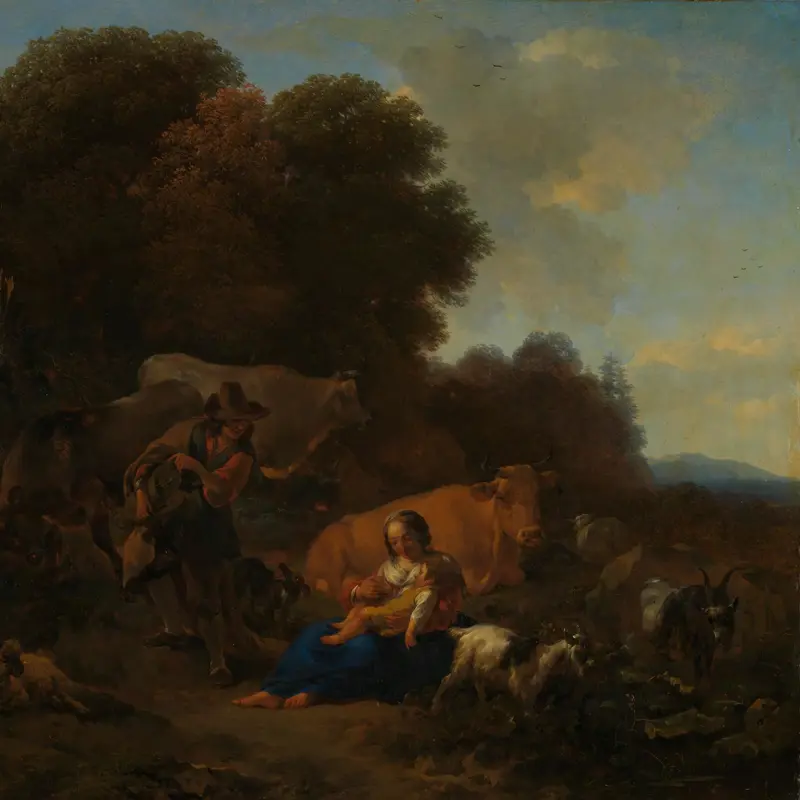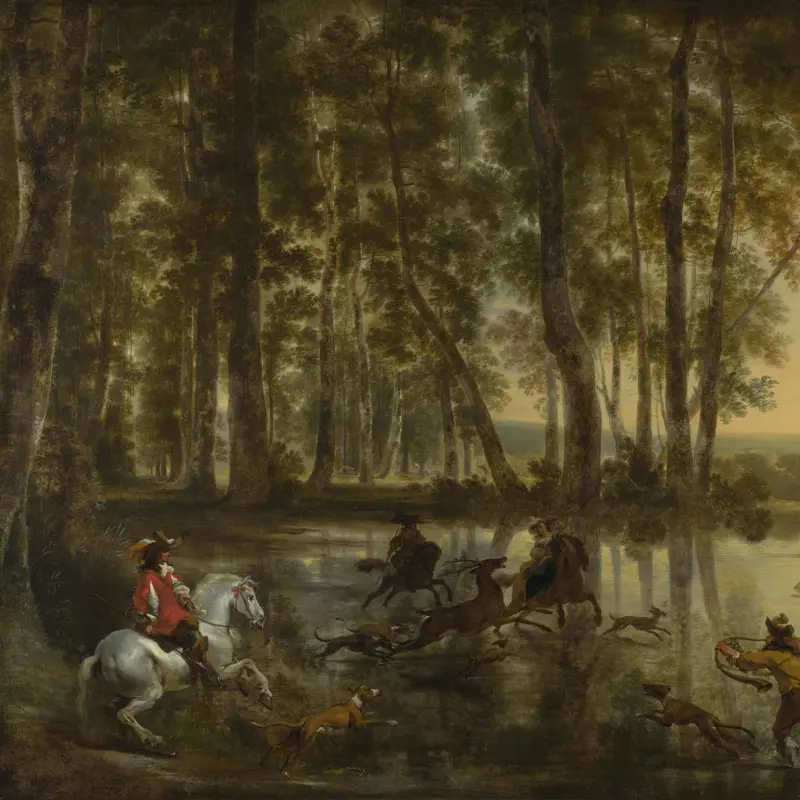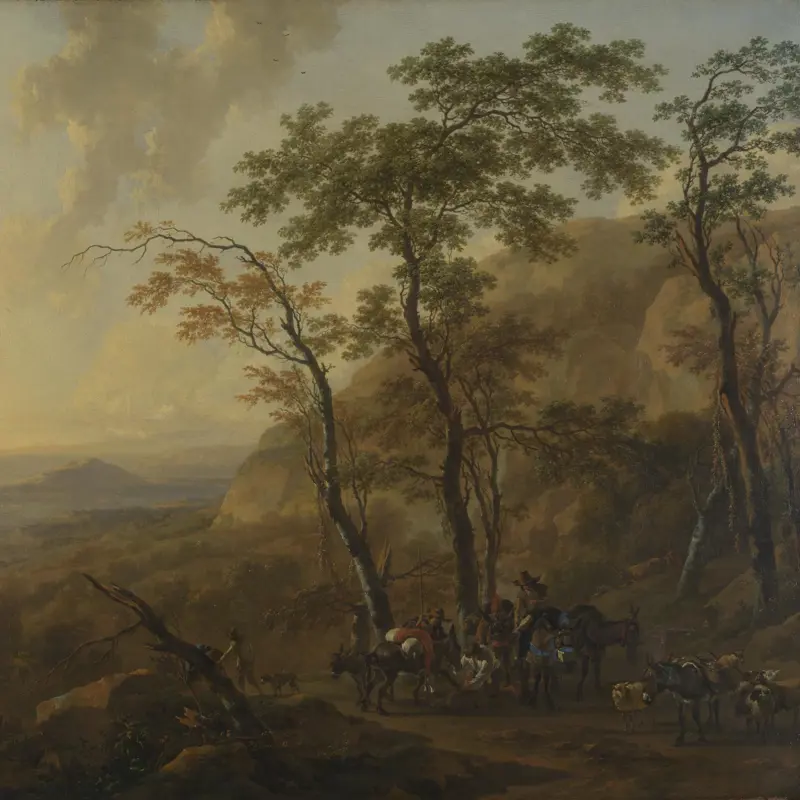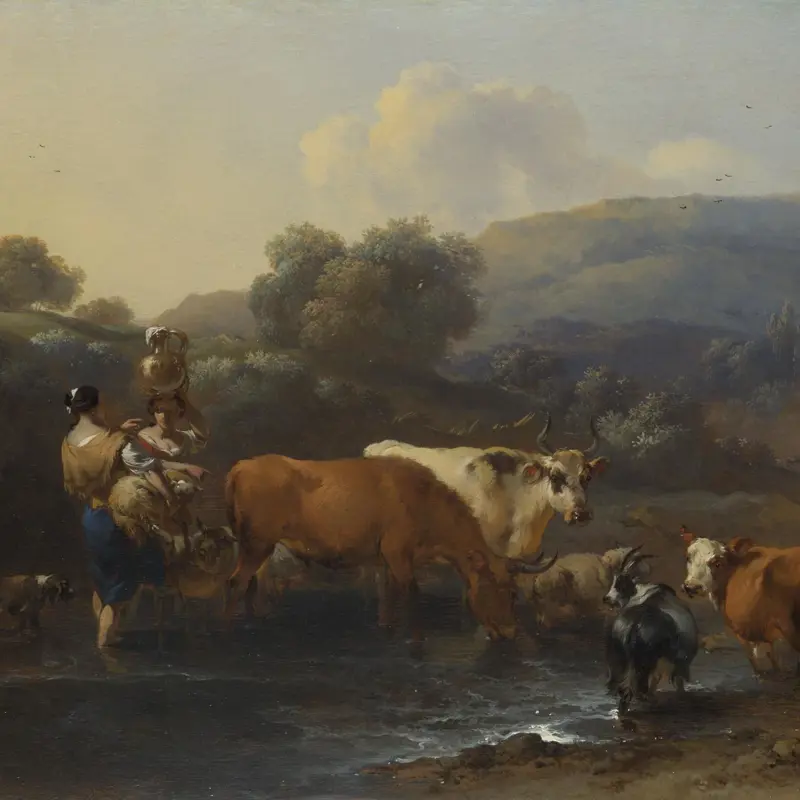Nicolaes Berchem, 'Peasants by a Ruined Aqueduct', probably 1655-60
About the work
Overview
The evening sun touches the sturdy cattle standing at the foot of the ruins of a Roman archway. The soft light casts shadows on the weather-worn stones, displaying the ruin’s age and former grandeur. The hills behind may have been recorded by Berchem during a possible stay in Italy, but the cows are unmistakably Dutch cows, highly valued for their vital place in the Dutch economy.
Berchem’s work, like that of other Italianate painters –- who had lived in Italy and been influenced by the work of Italian artists, the southern landscape and the remnants of Antiquity – was prized by collectors until well into the nineteenth century, but then began to be seen as ‘un-Dutch’ and therefore less interesting. The picture became part of Sir Robert Peel’s large collection of Dutch and Flemish paintings. When the collection was bought for the nation in 1871, the taste for such paintings was perhaps already seen as old-fashioned. Italianate landscapes were more widely appreciated after a groundbreaking exhibition held in 1965.
Key facts
Details
- Full title
- Peasants with Four Oxen and a Goat at a Ford by a Ruined Aqueduct
- Artist
- Nicolaes Berchem
- Artist dates
- 1620 - 1683
- Date made
- probably 1655-60
- Medium and support
- oil on wood
- Dimensions
- 47.1 × 38.7 cm
- Inscription summary
- Signed
- Acquisition credit
- Bought, 1871
- Inventory number
- NG820
- Location
- Room 39
- Collection
- Main Collection
- Previous owners
- Frame
- 20th-century Replica Frame
Provenance
Additional information
Text extracted from the ‘Provenance’ section of the catalogue entry in Neil MacLaren, revised and expanded by Christopher Brown, ‘National Gallery Catalogues: The Dutch School: 1600–1900’, London 1991; for further information, see the full catalogue entry.
Exhibition history
-
2012The Comte de Vaudreuil: Courtier and CollectorThe National Gallery (London)7 March 2012 - 12 June 2012
Bibliography
-
1829
J. Smith, A Catalogue Raisonné of the Works of the Most Eminent Dutch, Flemish, and French Painters: In Which is Included a Short Biographical Notice of the Artists, with a Copious Description of Their Principal Pictures […], 9 vols, London 1829-1842
-
1844A.M. Jameson, Companion to the Most Celebrated Private Galleries of Art in London: Containing Accurate Catalogues, Arranged Alphabetically, for Immediate Reference, Each Preceded by an Historical & Critical Introduction […], London 1844
-
1907C. Hofstede de Groot, Catalogue Raisonné of the Works of the Most Eminent Dutch Painters of the Seventeenth Century, 10 vols, London 1907
-
1907C. Hofstede de Groot, Catalogue Raisonné of the Works of the Most Eminent Dutch Painters of the Seventeenth Century, 10 vols, London 1907
-
1960Maclaren, Neil, National Gallery Catalogues: The Dutch School, 2 vols, London 1960
-
1982H.R. Hoetink, 'The Evolution of the Art Market and Collecting in Holland', International Journal of Museum Management and Curatorship, I/2, 1982, pp. 107-18
-
1983C. Brown, 'Rubens' Watering Place: An Examination of His Landscape Technique', Ringling Museum of Art Journal, 1983, pp. 130-49
-
1991Maclaren, Neil, revised by Christopher Brown, National Gallery Catalogues: The Dutch School, 1600-1900, 2nd edn (revised and expanded), 2 vols, London 1991
-
2001
C. Baker and T. Henry, The National Gallery: Complete Illustrated Catalogue, London 2001
About this record
If you know more about this work or have spotted an error, please contact us. Please note that exhibition histories are listed from 2009 onwards. Bibliographies may not be complete; more comprehensive information is available in the National Gallery Library.
